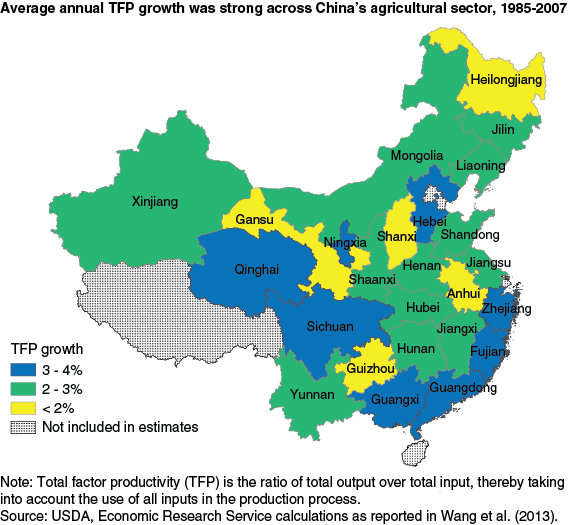China’s Agricultural Productivity Growth: Strong But Uneven
- by Sun Ling Wang and Fred Gale
- 6/3/2013
China’s agricultural productivity grew rapidly following the implementation of a series of economic reforms since 1978. Reforms led to more efficient resource allocation. China also began to disseminate new technologies (including improved seed varieties and animal breeds) and encourage mechanization. These “agricultural modernization” efforts laid a broad foundation for improved agricultural productivity. But evidence suggests that this growth may not continue into the future. With about 20 percent of the world’s population, 6.5 percent of its land area, and rising living standards, China’s ability to improve farm productivity will have a direct bearing on global food markets. China is already the leading importer of soybeans and cotton and has recently emerged as an importer of other major commodities, including corn, pork, wheat, and rice. A slowdown in productivity growth could bring further demand for imports.
During 1985-2007, China’s agricultural output growth (in real terms) averaged 5.1 percent annually. Two developments underlie this growth: greater use of inputs and growth in what economists call “total factor productivity” (TFP), or the ability to produce more output from each unit of input. TFP growth contributed 2.7 percentage points to the growth in China’s agricultural output while rising use of inputs contributed 2.4 percentage points. The mix of inputs changed as use of intermediate goods (including energy, pesticides, fertilizer, seed, feed, and other materials) grew 6.4 percent annually, offsetting declines in the use of labor and land. China’s roughly equal reliance on increased input use and TFP contrasts with the recent experience of developed countries where TFP accounts for nearly all growth in agricultural output. For example, annual growth in U.S. agricultural TFP contributed 1.22 percentage points while input growth contributed 0.03 percentage points to output growth over 1985-2007.
All of China’s regions have experienced strong growth in agricultural production since the mid-1980s fueled by both input and TFP growth, but the relative contribution of these two factors differs by region. Provinces with the most rapid TFP growth include a mix of coastal regions that led China’s economic development and several western provinces. Most northeastern and northern provinces exhibited more input growth. Although the growing economy has pulled labor and land away from farming, the development of China’s nonfarm sectors may have benefited farming by generating funds for investment in public infrastructure, science, and technology. Relaxed restrictions on foreign trade and investment may also have enhanced agricultural productivity by improving access to new technology and new markets.
However, the rapid growth in the past few decades may not have been sustained in recent years. Annual TFP growth peaked during 1996-2000 at 5.1 percent before slowing to 3.2 percent in 2000-2005. It then declined by 3.7 percent per year in 2005-07. The significance of this slowdown remains unclear. It may reflect a turning point in China’s agricultural productivity growth, in which case gains from earlier reforms and technology transfers from developed countries have been exhausted. Alternatively, it may simply be the effect of transitory events such as animal disease epidemics or discrepancies in data. As urbanization draws more labor and land from agriculture and accelerates changes in food consumption, the capacity to reestablish positive agricultural TFP growth is important to China’s future.
This article is drawn from:
- China Agricultural and Economic Data. (n.d.). U.S. Department of Agriculture, Economic Research Service.
- 'China’s Regional Agricultural Productivity Growth in 1985-2007: A Multilateral Comparison'. (2013). Agricultural Economics, Vol. 44, No. 2: 241-251.
You may also like:
- Agricultural Productivity in the United States. (n.d.). U.S. Department of Agriculture, Economic Research Service.


